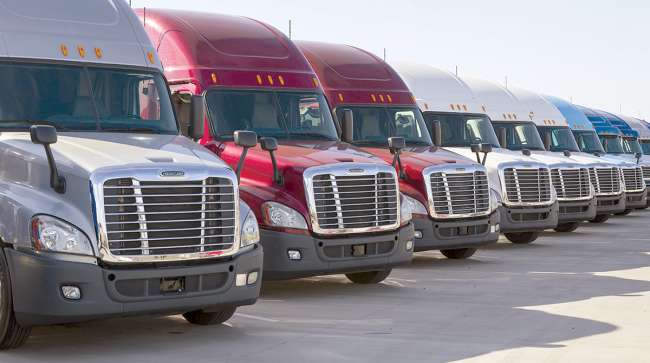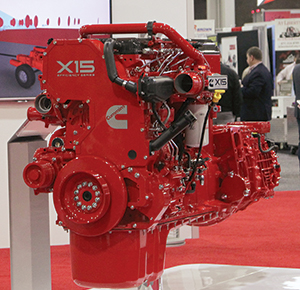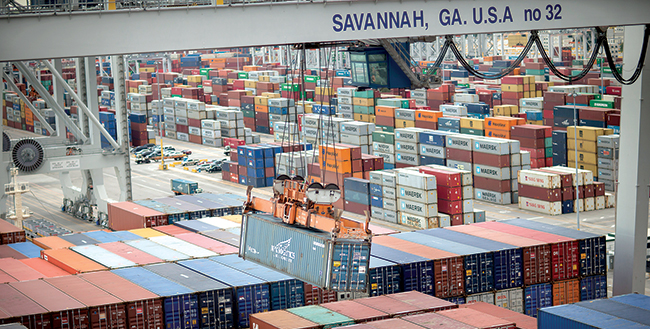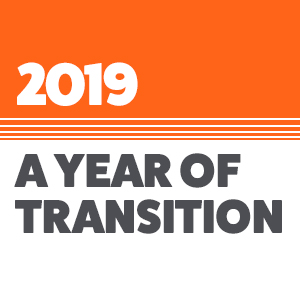Staff Reporter
2019: Freight Market Slowdown, Tariffs Diminished Trucking Industry's Performance

[Stay on top of transportation news: Get TTNews in your inbox.]
If 2018 was one big party for the trucking and freight business, 2019 was the day after the party.
A year ago, motor carriers, logistics firms and freight shippers were buoyed by many of the same factors that lifted their customers: U.S. consumers spending big on e-commerce, a lower corporate tax rate, and affordable and abundant fuel. But after last year’s rush to capitalize on that booming market, carriers this year found themselves with an abundance of capacity and fewer loads — along with a host of other challenges.
A lengthy trade spat between the United States and China — which had begun to thaw as 2019 drew to a close — caused freight to slow during the year, according to Bob Costello, chief economist for American Trucking Associations. Costello also blamed declines in U.S. manufacturing for lower freight volumes in 2019. All of this caused rates to soften — especially spot rates, Costello said, even as contractual rates remained fairly consistent.

Costello
Still, as time wore on, this confluence of factors took a toll on the industry. By Sept. 30, 795 trucking companies had shut down or declared bankruptcy, according to Broughton Capital. That was more than double the 310 in all of 2018, the lowest annual number on record.
Arguably, the highest-profile closure this year was Indianapolis-based Celadon Group, which on Dec. 9 announced it was filing for Chapter 11 bankruptcy and shutting its doors. The closure of Celadon, ranked No. 38 on the Transport Topics Top 100 list of the largest for-hire carriers in North America, came more than two years after an accounting scandal compelled the company to restate years’ worth of financial results and led to indictments against former management.
The industrywide downturn did not immediately affect truck sales, however, perhaps because of strong 2018 freight demand. Class 8 retail sales thrived in 2019 even as orders plunged for heavy-duty trucks and trailers.
Business: Freight Market Slowdown, Tariffs Diminished Trucking Industry's Performance
Government: Hours-of-Service Rule, ELDs and Roads Dominated Political, Regulatory Concerns
Timeline: Trucking's biggest moments
Top 10 stories: A mixed bag of industry news
Charts: Truck sales, trailer orders, tonnage figures
Decade in Review: Looking back at front pages since 2010
U.S. Class 8 retail sales started above replacement levels, about 16,000 per month, as near-record orders placed in 2018 were delivered to customers. As the second half of 2019 arrived, a familiar industry pattern re-emerged — fleets continued to take on capacity despite slowing freight growth and rising economic uncertainty. Sales soared to an all-time record of 28,258 in September, led by Freightliner’s sales of 11,654.
Meanwhile, North American Class 8 orders got off to a slow start, with open build slots scarce as factories worked through heavy backlogs. Orders in January plummeted to 15,800 compared with 48,700 a year earlier — a gap that set the tone for the rest of the year. By July, trade uncertainty and freight jitters sent orders to their lowest level since July 2010. And by autumn, all truck makers and two key suppliers — Meritor Inc. and SAF Holland — countered reduced demand by announcing plans to either cut jobs and reduce build rates or flex work hours. By November, Class 8 orders fell to the lowest level, 17,500, for any November since 2015.
At the same time, trailer makers entered 2019 on the heels of a record-setting 2018 when 422,351 orders were taken. January’s U.S. net orders of nearly 26,000 marked the third consecutive month the backlog increased to record levels, but supply chain issues remained in play — slowing deliveries of components and finished trailers.
“Essentially all production slots are assigned,” Hyundai Translead Chief Sales Officer Stuart James said in March.
Against that backdrop, trailer orders sunk. That changed in October — the beginning of the traditionally strong fourth quarter — when orders climbed to 31,900.
However, the engine maker with the largest share of heavy-duty engines, Cummins Inc., announced in November it would lay off 2,000 salaried employees in the first quarter of 2020, attributing the decision to softening demand in trucking.

A Cummins X15 engine. (John Sommers II for Transport Topics)
Despite trucking officials’ and economists’ consistent talk of the softening environment, truck tonnage was slightly higher when compared with 2018’s strong year. ATA said in late November that its tonnage index was up 3.9% year-to-date when measured against the previous year. Except, as noted earlier, for the spot market.
“The spot market was growing really strong in 2017 and 2018 and now it’s negative,” Costello said. “When you compare it to the last couple of years, it’s off 50%. This is where the freight recession resides, on the truckload side.”
Signs of trouble could be seen in the fuel markets throughout 2019, as oil did not approach $100 per barrel amid concerns about the weakening global economy and the U.S.-China tariff saga. But this was good for trucking: Diesel, the industry’s main fuel, saw little price fluctuation during the year. On Dec. 10, 2018, diesel cost $3.161 per gallon, according to the U.S. Department of Energy. On Dec. 9, diesel came in at $3.049 per gallon, an 11.2-cent drop in a year.
Strong U.S. refining capacity kept prices stable, noted Dean Foreman, chief economist for the American Petroleum Institute. This, coupled with record U.S. oil production, kept diesel affordable even as U.S. demand stayed high — in October, consumption reached about 4.2 million barrels per day.
However, concerns swirled all year about the potential effects of a mandate that large ships begin burning cleaner fuel in 2020.
The International Maritime Organization has directed ships to stop using high-sulfur bunker fuel in favor of a lower-sulfur mix drawn from distillates. But as the mandate approached, diesel prices remained undisturbed by this potential new drain on supplies.
“Right now, the IMO mandate is the dog that has not barked,” said Tom Kloza, global head of energy analysis for the Oil Price Information Service. “But it has growled a little.”

Kloza
Oil prices did take a short-term jump after a Sept. 14 missile attack on Saudi Arabian oil fields that the Saudis and the U.S. blamed on Iran. While the Department of Energy reported that diesel rose 9.4 cents to $3.081 per gallon Sept. 23, prices quickly fell back down.
“[2019] was another cheap year for oil,” Kloza said. “It started in 2015, so this was the fifth cheap year in a row.”
Inexpensive diesel helped shippers maneuver the uncertainty caused by the U.S. tariff war with China as they kept making speculative shipments to fill U.S. warehouses. Costello noted uneven activity from China caused tonnage numbers to become volatile by year’s end.
Through 2019, the trade war also kept port officials on edge, even as they spent big to improve their facilities’ ability to handle larger ships. On both the East and West coasts, the nation’s major ports continued investing to increase capacity with deeper shipping channels and larger cranes.

Containers at the Port of Savannah. (Georgia Ports Authority)
“The long term wins the day, and I think that’s why you’re seeing the ports investing in their infrastructure,” said Chris Connor, the new CEO of the American Association of Port Authorities.
One of the biggest expansion initiatives is at the Port of Savannah, which plans to double its capacity by the mid-2020s from its current 5.5 million 20-foot-equivalent units per year to more than 11 million TEUs.
A bright spot for shippers amid the trade war was e-commerce. While consumers’ growing online spending habits boosted demand for final-mile deliveries, some carriers struggled to incorporate the service into their operations. One was Schneider, which had been operating a final-mile unit for three years. The Green Bay, Wis., carrier said Aug. 1 that it would shutter its Schneider Direct segment.
Despite this, other companies see opportunity in the sector — especially in specific segments.
“Consumers are increasingly comfortable buying big and bulky items online,” Daniel Walsh, president of XPO Logistics Inc.’s final-mile business, told TT. “In the past, there was a tendency to browse, but only buy after an in-store visit and a physical touch. That is changing, and now many more have become comfortable completing the entire transaction virtually.”
Walsh noted that XPO’s direct-to-consumer business has grown as large national companies use its network of 85 “last-mile hubs” to move products to customers — including items such as furniture and computers, an indication heavy freight is part of the final-mile family.
An XPO spokesman told TT that a survey the company took at the end of 2019 found 71% of consumers said they are likely to buy goods weighing more than 150 pounds online, and 41% indicated they will pay for installation services if needed.
Another major player entering the fray is FedEx Freight. In an exclusive interview with TT, CEO John Smith discussed the opportunity his company sees in “crossing the threshold” into customers’ homes.
“Over the last 10 years, we’ve all seen the e-commerce business just explode,” he said in October. “It used to be smaller items they would order online that would be delivered directly to the house. Now, more and more, they’re feeling more comfortable ordering anything that you can order and having it delivered.
“We feel like that’s going to continue, and that’s why we feel like we need to get into this business.”
Staff Reporter Roger Gilroy and Associate News Editor Dan Ronan also contributed to this article.
Want more news? Listen to today's daily briefing:




